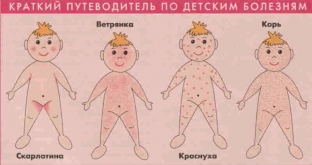During the first few years of life, any, even the most healthy child, suffers from childhood infectious diseases. After that, the body has an immunological memory for certain types of viruses, which allows the child to not get sick with these diseases in the future. It has long been known that it is necessary to recover from childhood infectious diseases precisely in childhood, when the process is easier to tolerate. Doctors have a task - to identify the disease in time, differentiate it and competently help the body fight the disease. What are the main childhood infectious diseases? How do they differ from each other in the clinical picture?
What is the rash in the main childhood infectious diseases?
The main childhood infectious diseases are: measles, mumps, rubella, chickenpox, scarlet fever, and erythema infectiosum. The ways of infection with these children's infectious diseases are airborne. The smallest incubation period has scarlet fever – from several hours to 7 days. Erythema infectiosum and measles have an incubation period of 1-2 weeks, mumps, measles and varicella have the longest incubation period of 2-3 weeks.
The symptom of intoxication, which implies headache, severe weakness, body aches and whims of the child, is most pronounced in bark and scarlet fever, in other diseases moderate intoxication. Accordingly, the increase in body temperature in measles and scarlet fever can reach 400C and above. But the main criterion that is taken into account in the diagnosis of childhood infectious diseases is the nature of the rash and its localization.
The nature of the rash in childhood infectious diseases:
- Measles – the rash is spotty-papular, flat, has a different diameter, polymorphic, can merge. The rash appears in stages, after 3 days.
- Rubella – small - spotted rash on unchanged skin that does not merge with each other. No phasing is noted. Exanthema on extensor surfaces. The rash appears from the first day of illness.
- Mumps – no rashes.
- Scarlet fever – finely - dotted rash of bright red color on hyperemic skin. It merges over time, and a continuous reddening is formed. The rash appears from the first day of illness.
- Chickenpox – characterized by fake polymorphism. That is, first the rash element – roseola, later it turns into a papule, then into a vesicle, then into a pustule with contents. After opening the pustules, crusts form. At the same time, all these elements can be on the skin. The rash with chickenpox is itchy, appears at the end of the first day or at the beginning of the second day.
- Erythema infectiosum – first red dots appear, then spots, which later become swollen with a pale center inside.
Localization of rash in childhood infectious diseases

Not only the nature and timing of the rash, but also its localization is important. Localization of the rash in childhood infectious diseases:
- Measles – a rash appears on the face and behind the ears, spreading to the body and arms.
- Rubella – rashes appear on the face, then spread to the whole body. There are exanthems on the extensor surfaces of the arms, enanthems on the soft palate.
- Scarlet fever – elements of the rash are noted throughout the body, most clearly localized in the folds. The only place where the rash is absent is the nasolabial triangle.
- Chickenpox – rashes all over the body and face, spreading to the mucous membranes.
- Erythema infectiosum – the rash appears first on the cheeks, spreading all over the body.
In addition to the skin, in childhood infectious diseases, the mucous membrane is also subject to pathological changes.
Changes in the mucous membranes in childhood infectious diseases
If a child has measles, there are specific changes on the mucous membrane of the oropharynx – Filatov-Koplik spots, which look like small white poppy grains. The mucosa is edematous and plethoric. The child has photophobia and blepharospasm.
With rubella, nasopharyngitis, swelling and enanthems in the soft palate are noted. Scarlet fever is manifested by the presence of a clear boundary between the soft and hard palate, which in medicine is called "burning throat". The soft palate at the same time has a bright red color, delimited from the hard palate. With scarlet fever, tonsillitis develops.
The oropharynx with chickenpox is edematous, hyperemic, aphthous stomatitis is observed. In mumps, the oropharynx is edematous, hyperemic, and there is a positive symptom of Murs (swelling and hyperemia of the stenon duct). Rhinitis is characteristic of erythema infectiosum.
If a child is diagnosed with a childhood infectious disease, specific treatment should be started immediately to avoid life-threatening complications.







Add a comment